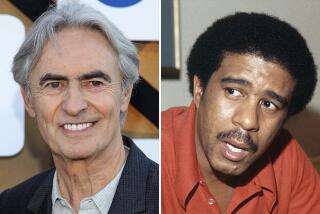Shrinking of the cartoon balloon
- Share via
WHEN Adolph Ochs purchased the New York Times in 1896, he decided to swim against a tide that was then running at full flood through the country’s hyper-competitive urban newspaper scene.
American newspapers had printed occasional editorial cartoons for decades, but the bitter -- and well-financed -- presidential campaign between William McKinley and William Jennings Bryant had made exclusive political cartoons by a resident artist a must-have feature among the big city dailies. Ochs’ competitors at the New York World, Journal and Post all had one on staff.
The new publisher, however, decided that his paper’s editorial page would not have a cartoonist because visual caricature and satire were instruments too blunt for the sort of newspaper he envisioned. Ochs is supposed to have said that the problem with a cartoon was that it couldn’t be made to say, “On the other hand .... “
That’s true, of course, but on the other hand, sometimes there are things that need to be said unambiguously -- in black and white, as it were.
In fact, for much of the last century, editorial cartoonists have challenged their editors and publishers to distinguish clearly between their duty to nuance and the temptation toward expedient temporizing.
As editor of a new collection of editorial cartoons rejected by newspaper editors -- “Killed Cartoons: Casualties From the War on Free Expression” -- David Wallis leaves no doubt about how he feels today’s editors and publishers are living up to that challenge. The anthology is a kind of companion to a similarly named volume of rejected print journalism collected and edited by Wallis. In this case, there is a rambling and rather disorganized introduction by the editor followed with numerous examples of killed cartoons by leading editorial artists, most occurring over the last few years. Brief statements by the artists about cartooning and the circumstances of the particular rejection accompany the examples. They’re the best part -- with a reservation. The cartoonists explain why they believe their work was rejected. The editors who made the decision never are asked to weigh in. In some instances, entire conversations between the cartoonist and the editor are reproduced verbatim -- apparently from memory, unless, of course, the cartoonist was wearing a wire. Given the circumstances, it seems a bit much to ask readers to take on faith.
Wallis is a writer and founder of a syndicate that essentially resells previously published articles. Since he’s remarkably casual about imputing economic motives to the editors who rejected the cartoons in this book, it doesn’t seem too unfair to wonder whether too many unsuccessful sales pitches haven’t given him a slightly jaundiced view of his customers.
It isn’t too untoward a foray into caricature to describe Wallis’ view thus: The great tradition of editorial cartooning is being whittled away by timid editors cowed by the post-9/11 political climate, the Bush administration’s malevolent hostility toward the press and free expression, the publishers’ fear of offending advertisers and the editors’ general timidity, exacerbated by their anxiety over offending their publishers and undermining their own financial security. Something of the flavor of his analysis is to be had from this quotation: “The silencing of editorial artists -- historically a progressive voice in the press -- comes at a time when the mainstream media bends over backward -- or just bends over -- to appease conservatives.” Why this propensity hasn’t simply led to a dramatic increase in the number of conservative cartoonists is the sort of unanswered -- in fact, unasked -- question in which this book abounds.
Official antipathy to cartoonists hardly is a new phenomenon. Boss Tweed famously fumed over Thomas Nast’s “damned pictures.” In 1899, the California Legislature passed “the Cartoon Act,” which forbade the publication of caricatures that reflected badly on the subject’s character. Richard Nixon put The Times’ Paul Conrad on his enemies list.
In a couple of instances, the editor of this book touches on a larger and -- one suspects -- more long-lasting reason for the sad state of editorial cartooning, and that state is sad, indeed. Wallis is on the money when it comes to that point ... in a couple of senses. The current round of economic cutbacks spreading through the newspaper industry like a toxic plume has proved particularly poisonous for cartoonists. When coupled with the consolidation of previously independent papers into corporate-owned chains, the effect on editorial cartooning has been devastating. Paper after paper has eliminated its own cartoonist in favor of cheap, readily available and mostly undistinguished work.
According to work done for the Nieman Foundation, American newspapers employed nearly 200 editorial cartoonists in the early 1980s. By 2004, there were fewer than 90, and the number has dropped further since then. For many years, the Los Angeles Times employed not one but two editorial cartoonists -- Frank Interlandi and the great Conrad, a three-time Pulitzer Prize winner. Two years ago, the paper let go Michael Ramirez, also a Pulitzer recipient, as part of a staff reduction directed by the Tribune Co. There are no plans to replace him.
One of the things missing from this collection, however, is a sense of just how fraught dealing with a good cartoonist can be, even for a conscientious editor. Cartoonists are complicated artists. Nast, who is the American genre’s founding father, bequeathed us such ubiquitous political icons as Uncle Sam and the elephant and donkey as symbols of the Republican and Democratic parties. He was an early champion of abolition, supported Lincoln through the Civil War, helped drive the corrupt Tweed out of public life, was a rare advocate on behalf of Native Americans’ rights and defended Chinese immigrants. On the other hand, though himself foreign-born, Nast was viciously bigoted toward the Irish immigrants and, particularly, toward the Roman Catholic Church. That prejudice drove him into the arms of New York’s resurgent Nativist faction and resulted in some of the most vile caricatures ever published in the American press.
Would an editor who gladly published Nast’s attacks on slavery but rejected cartoons that portrayed the Irish as apes and their bishops as crocodiles really have been an enemy of “free expression”? Might he not simply have been ... an editor?
More to Read
The biggest entertainment stories
Get our big stories about Hollywood, film, television, music, arts, culture and more right in your inbox as soon as they publish.
You may occasionally receive promotional content from the Los Angeles Times.










